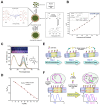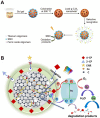Small Toxic Molecule Detection and Elimination Using Molecularly Imprinted Polymers (MIPs)
- PMID: 40558475
- PMCID: PMC12190631
- DOI: 10.3390/bios15060393
Small Toxic Molecule Detection and Elimination Using Molecularly Imprinted Polymers (MIPs)
Abstract
Molecularly imprinted polymers (MIPs) provide selective, robust, and cost-effective platforms for the detection and removal of small toxic molecules in environmental, food, and biomedical contexts. This review offers a comprehensive overview of recent advancements in MIP-based systems, emphasizing critical design factors such as template selection, functional monomers, polymerization methods, and binding kinetics. The impact of these parameters on improving sensitivity, selectivity, and reusability is thoroughly examined. Additionally, current advantages, limitations, and enduring challenges are addressed. By highlighting emerging strategies and interdisciplinary innovations, this work aims to guide the development of more efficient and sustainable technologies for small-molecule toxin detection and remediation.
Keywords: elimination; molecular imprinted polymer; sensing; small toxic molecules.
Conflict of interest statement
The authors declare no conflicts of interest.
Figures









References
-
- Chakraborty A., Adhikary S., Bhattacharya S., Dutta S., Chatterjee S., Banerjee D., Ganguly A., Rajak P. Pharmaceuticals and personal care products as emerging environmental contaminants: Prevalence, toxicity, and remedial approaches. ACS Chem. Health Saf. 2023;30:362–388. doi: 10.1021/acs.chas.3c00071. - DOI
-
- Mitra S., Chakraborty A.J., Tareq A.M., Emran T.B., Nainu F., Khusro A., Idris A.M., Khandaker M.U., Osman H., Alhumaydhi F.A. Impact of heavy metals on the environment and human health: Novel therapeutic insights to counter the toxicity. J. King Saud Univ.-Sci. 2022;34:101865. doi: 10.1016/j.jksus.2022.101865. - DOI
-
- Singh P.K., Kumar U., Kumar I., Dwivedi A., Singh P., Mishra S., Seth C.S., Sharma R.K. Critical review on toxic contaminants in surface water ecosystem: Sources, monitoring, and its impact on human health. Environ. Sci. Pollut. Res. Int. 2024;31:56428–56462. doi: 10.1007/s11356-024-34932-0. - DOI - PubMed
-
- Wu Y.S., Osman A.I., Hosny M., Elgarahy A.M., Eltaweil A.S., Rooney D.W., Chen Z., Rahim N.S., Sekar M., Gopinath S.C.B., et al. The Toxicity of Mercury and Its Chemical Compounds: Molecular Mechanisms and Environmental and Human Health Implications: A Comprehensive Review. ACS Omega. 2024;9:5100–5126. doi: 10.1021/acsomega.3c07047. - DOI - PMC - PubMed
Publication types
MeSH terms
Substances
Grants and funding
LinkOut - more resources
Full Text Sources

